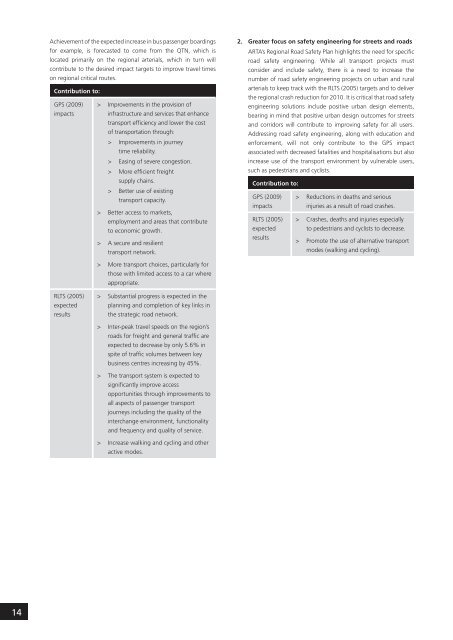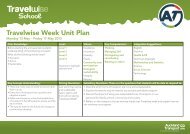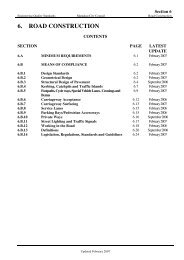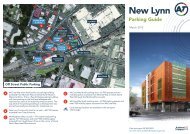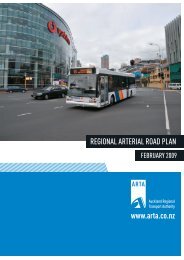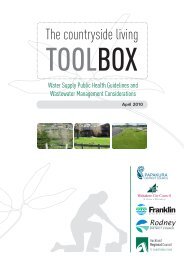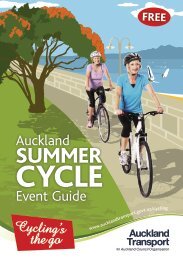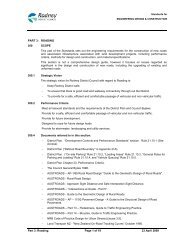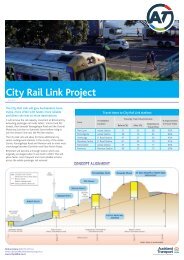Regional Land Transport Programme 2009 - 2010 (2MB) - Auckland ...
Regional Land Transport Programme 2009 - 2010 (2MB) - Auckland ...
Regional Land Transport Programme 2009 - 2010 (2MB) - Auckland ...
You also want an ePaper? Increase the reach of your titles
YUMPU automatically turns print PDFs into web optimized ePapers that Google loves.
Achievement of the expected increase in bus passenger boardings<br />
for example, is forecasted to come from the QTN, which is<br />
located primarily on the regional arterials, which in turn will<br />
contribute to the desired impact targets to improve travel times<br />
on regional critical routes.<br />
Contribution to:<br />
GPS (<strong>2009</strong>)<br />
impacts<br />
> Improvements in the provision of<br />
infrastructure and services that enhance<br />
transport efficiency and lower the cost<br />
of transportation through:<br />
> Improvements in journey<br />
time reliability.<br />
><br />
><br />
Easing of severe congestion.<br />
More efficient freight<br />
supply chains.<br />
> Better use of existing<br />
transport capacity.<br />
> Better access to markets,<br />
employment and areas that contribute<br />
to economic growth.<br />
> A secure and resilient<br />
transport network.<br />
2. Greater focus on safety engineering for streets and roads<br />
ARTA’s <strong>Regional</strong> Road Safety Plan highlights the need for specific<br />
road safety engineering. While all transport projects must<br />
consider and include safety, there is a need to increase the<br />
number of road safety engineering projects on urban and rural<br />
arterials to keep track with the RLTS (2005) targets and to deliver<br />
the regional crash reduction for <strong>2010</strong>. It is critical that road safety<br />
engineering solutions include positive urban design elements,<br />
bearing in mind that positive urban design outcomes for streets<br />
and corridors will contribute to improving safety for all users.<br />
Addressing road safety engineering, along with education and<br />
enforcement, will not only contribute to the GPS impact<br />
associated with decreased fatalities and hospitalisations but also<br />
increase use of the transport environment by vulnerable users,<br />
such as pedestrians and cyclists.<br />
Contribution to:<br />
GPS (<strong>2009</strong>) > Reductions in deaths and serious<br />
impacts<br />
injuries as a result of road crashes.<br />
RLTS (2005) > Crashes, deaths and injuries especially<br />
expected<br />
to pedestrians and cyclists to decrease.<br />
results<br />
> Promote the use of alternative transport<br />
modes (walking and cycling).<br />
RLTS (2005)<br />
expected<br />
results<br />
><br />
><br />
><br />
><br />
><br />
More transport choices, particularly for<br />
those with limited access to a car where<br />
appropriate.<br />
Substantial progress is expected in the<br />
planning and completion of key links in<br />
the strategic road network.<br />
Inter-peak travel speeds on the region’s<br />
roads for freight and general traffic are<br />
expected to decrease by only 5.6% in<br />
spite of traffic volumes between key<br />
business centres increasing by 45%.<br />
The transport system is expected to<br />
significantly improve access<br />
opportunities through improvements to<br />
all aspects of passenger transport<br />
journeys including the quality of the<br />
interchange environment, functionality<br />
and frequency and quality of service.<br />
Increase walking and cycling and other<br />
active modes.<br />
14


